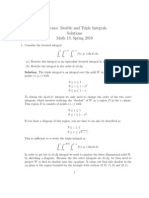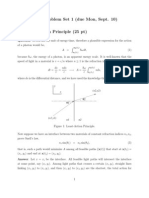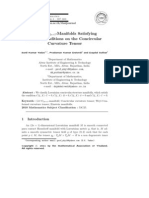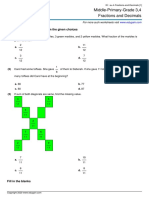Quantum Particle Creation Near Strong Curvature Regions 1
Quantum Particle Creation Near Strong Curvature Regions 1
Uploaded by
ေအာင္ ေက်ာ္ စြာCopyright:
Available Formats
Quantum Particle Creation Near Strong Curvature Regions 1
Quantum Particle Creation Near Strong Curvature Regions 1
Uploaded by
ေအာင္ ေက်ာ္ စြာOriginal Description:
Original Title
Copyright
Available Formats
Share this document
Did you find this document useful?
Is this content inappropriate?
Copyright:
Available Formats
Quantum Particle Creation Near Strong Curvature Regions 1
Quantum Particle Creation Near Strong Curvature Regions 1
Uploaded by
ေအာင္ ေက်ာ္ စြာCopyright:
Available Formats
Quantum Particle Creation Near Strong
Curvature Regions
1 Introduction
One of the most important issues in current relativity theory is the occurence
of singular regions in the space-times. Singular regions, if naked, have far
reaching implications. One of the very familiar example is the big bang
singularity in cosmological models. The study of gravitational collapse in
cases of imploding radiations, dust etc. have also pointed out the existance of
naked singularities. Theoretically singularities(naked or covered) are bound
to occur in relativity theory under certain general conditions imposed on the
stress energy tensor. However, these classically reasonable conditions may
not hold if the matter eld is quantized. In the late stages of gravitational
collapse when regions of strong gravitational elds develop and the matter is
compactied in region of spacetime of the order of planck length, it becomes
important to examine the quantum eects in the near singular regions of the
space-times. The Consideration and study of quantum eects, is therefore
important and it may lead to avoidance of singularities. An equally important
question is the nature of the spontaneous particle creation in the extreme
curvature regions of the space-times.
2 Particle Creation in the Marginally Bound,
Self Similar Collapse of Inhomogeneous Dust
Let us consider a collapsing dust cloud. The eld of a inhomogeneous dust
cloud is described by the Tolman-Bondi metric given by *Tolman and Bondi.
The metric is well known and given in comoving coordinates by
ds
2
= dt
2
R(t, r)
2
dr
2
R
2
(t, r)d
2
(1)
The dust cloud is made up of concentric shells each labelled by r.
R(t, r)is
the physical radius of such shells in the sense that the area of a shell labelled
by r is given by 4R
2
(t, r)).
R(t, r) denotes the derivative of
R(t, r)with
respect to r. The stress energy tensor describing the dust is
T
= (t, r)
0
. (2)
1
Where u
a
= delta
a
0
represent the four velocity of dust particles.
*We are interested only in the marginally bound self similar collapse
which is given by,
R(t, r) = r
_
1
3
2
t
r
_
2
3
(3)
The physical radius is seen to depend on one parameter, , (the mass pa-
rameter). This parameter determines the total mass,M(r),lying within the
shell labelled by ras 2GM(r) = r.The total mass of the dust is therefore
2GM = = r
0
where r
0
labels the outer boundary of the cloud. The ef-
fective two dimensional metric giving the eld of such a dust cloud is given
by
ds
2
= dt
2
R(t, r)
2
dr
2
(4)
where
R is the physical radius of the collapsing dust cloud. Using the vari-
ables (z, x) where z = lnr and x = t/r.
dr
2
= r
2
dz
2
. (5)
dt
2
= x
2
r
2
dz
2
+ 2xr
2
dxdz + r
2
dx
2
. (6)
Substituting equations (2)and (3) in equation (1), we get
ds
2
= r
2
_
dx
2
+ 2xdxdz + (x
2
R
2
(x))dz
2
_
. (7)
Now we will use the following,
= z +
1
2
(I
+ I
+
) =
1
2
(I
+ I
+
), (8)
I
=
_
dx
x
R
(9)
and equation (4) reads:
ds
2
= r
2
_
x
2
R
_
_
d
2
d
2
_
. (10)
The physical radius
R is given by,
R = r
_
1
3
2
t
r
_
2
3
(11)
R = e
z
_
1
3
2
t
r
_
2
3
(12)
2
and the transformed collapsing dust radius is,
R =
dR
dr
(13)
R =
(1
1
2
x)
(1
3
2
x)
1
3
(14)
We will evaluate the integrals of
I
=
_
dx
x
R
(15)
The new transformed parameters of and becomes,
= z +
_
_
_
xdx
x
2
R
2
_
_
d = dz +
xdx
x
2
R
2
and and hence,
dz
2
=
_
_d
xdx
(x
2
R
2
)
_
_
2
The value is dened as,
=
1
2
[I
I
+
] (16)
and, we have
=
_
Rdx
_
x
2
R
2
_ (17)
and therefore,
d =
Rdx
_
x
2
R
2
_ (18)
and
dx =
_
x
2
R
2
_
d
R
(19)
3
These values of dz
2
and dx
2
are substituted in equation (3)and it reads:
ds
2
= r
2
_
_
_
x
2
R
2
__
R
2
d
2
+
R
2
d
2
_
R
2
_
_
(20)
ds
2
= r
2
_
_
_
x
2
R
2
_
x
2
d
2
R
2
d
2
2x
2
d
2
+ x
2
d
2
+
R
2
d
2
R
2
_
_
(21)
ds
2
= r
2
_
x
2
R
2
_
(d
2
d
2
) (22)
For null coordinates such that in the limit as 0 these reduce to the
standard null coordinates in Minkowski space. Such coordinates are given
by u = +re
I
for x
R > 0region and u = re
I
for x
R < 0region.
v = +re
I
+
for x
R > 0region and v = re
I
+
for x
R < 0region.
To further analyze the causal structure, it is now convenient to go to the
variable y dened by y =
_
R
r
. In terms of y, the integralI
can be written.
For outgoing case, we have the following parameters,
I
+
(x) =
_
dx
x +
R
(23)
R = r
_
1
3
2
x
_
2
3
(24)
a =
3
2
(25)
y
2
=
_
1
3
2
x
_
2
3
(26)
y
3
= 1 ax (27)
x =
1 y
3
a
and
dx =
3y
3
a
dy
4
From above equation dx and xare substituted in I
+
.
Then
I
+
=
_
3y
2
a
dy
1
a
3
x
(1ax)
1
3
(28)
I
+
=
3y
2
a
dy
1y
3
a
+
2+y
3
3
y
(29)
I
+
=
_
9y
3
dy
3y 3y
4
+ 2a + ay
3
(30)
I
+
=
_
9y
3
dy
3y
4
ay
3
3y 2a
(31)
I
+
= 9
_
y
3
dy
3y
4
ay
3
3y 2a
(32)
Similarly, for incoming case,
I
=
_
dx
x
R
(33)
I
=
_ 3y
2
a
dy
1y
3
a
(1
a
3
x)
(1ax)
1
3
(34)
I
=
_ 3y
2
a
dy
_
1y
3
a
_
_
2+y
3
3
y
_ (35)
I
=
_
9y
3
dy
3y 3y
4
2a ay
3
(36)
I
= 9
_
y
3
dy
3y
4
ay
3
3y 2a
(37)
So the integral becomes
I
= 9
_
y
3
dy
3y
4
ay
3
3y 2a
(38)
and hence,
f
(y) = 3y
4
ay
3
3y 2a (39)
5
If we consider the coordinates with respect to f
(y).
For region x
R > 0
x
R > 0 (40)
(
1 y
3
a
)
(1
1
2
x)
(1
3
2
x)
1
3
> 0 (41)
(
1 y
3
a
)
(1
a
3
x)
(1 ax)
1
3
> 0 (42)
(
1 y
3
a
)
[1
a
3
(
1y
3
a
)]
[1 a(
1y
3
a
)
1
3
]
> 0 (43)
3y 3y
4
2a ay
3
3ay
> 0 (44)
3y
4
ay
3
+ 3y 2a > 0 (45)
3y
4
+ ay
3
3y + 2a < 0 (46)
f
(y) = 3y
4
+ ay
3
3y + 2a (47)
Therefore
f
(y) < 0 (48)
Similarly for region x
R < 0
(
1 y
3
a
)
(1
1
2
x)
(1
3
2
x)
1
3
< 0 (49)
(
1 y
3
a
)
(1
a
3
x)
(1 ax)
1
3
< 0 (50)
(
1 y
3
a
)
[1
a
3
(
1y
3
a
)]
[1 a(
1y
3
a
)
1
3
]
< 0 (51)
3y 3y
4
2a ay
3
3ay
< 0 (52)
3y
4
ay
3
+ 3y 2a < 0 (53)
3y
4
+ ay
3
3y + 2a > 0 (54)
f
(y) = 3y
4
+ ay
3
3y + 2a (55)
6
Therefore
f
(y) > 0 (56)
Similarly for region x +
R > 0
(
1 y
3
a
) +
(1
1
2
x)
(1
3
2
x)
1
3
> 0 (57)
(
1 y
3
a
) +
(1
a
3
x)
(1 ax)
1
3
> 0 (58)
(
1 y
3
a
) +
[1
a
3
(
1y
3
a
)]
[1 a(
1y
3
a
)
1
3
]
> 0 (59)
3y 3y
4
+ 2a + ay
3
3ay
> 0 (60)
3y
4
+ ay
3
+ 3y + 2a > 0 (61)
3y
4
ay
3
3y 2a < 0 (62)
f
+
(y) = 3y
4
ay
3
3y 2a (63)
Therefore
f
+
(y) < 0 (64)
Similarly for region x +
R < 0
(
1 y
3
a
) +
(1
1
2
x)
(1
3
2
x)
1
3
< 0 (65)
(
1 y
3
a
) +
(1
a
3
x)
(1 ax)
1
3
< 0 (66)
(
1 y
3
a
) +
[1
a
3
(
1y
3
a
)]
[1 a(
1y
3
a
)
1
3
]
< 0 (67)
3y 3y
4
+ 2a + ay
3
3ay
< 0 (68)
3y
4
+ ay
3
+ 3y + 2a < 0 (69)
7
3y
4
ay
3
3y 2a > 0 (70)
f
+
(y) = 3y
4
ay
3
3y 2a (71)
Therefore
f
+
(y) > 0 (72)
8
You might also like
- Free Fall Colla'seDocument3 pagesFree Fall Colla'sesendra20No ratings yet
- Htin Aung 1962 Burmese Law Tales Ocr TuDocument164 pagesHtin Aung 1962 Burmese Law Tales Ocr Tuေအာင္ ေက်ာ္ စြာ100% (1)
- Black Hole Lecture NotesDocument28 pagesBlack Hole Lecture NotesMaitraya BatmancharyyaNo ratings yet
- Relativistic Astrophysics. 2009. Course Work 5. Solutions: X X 2 X X 2 2Document5 pagesRelativistic Astrophysics. 2009. Course Work 5. Solutions: X X 2 X X 2 2ShootingStarPhotonsNo ratings yet
- Chap 3Document17 pagesChap 3Yessenia Madrid100% (1)
- Momento de Inercia EjerciciosDocument6 pagesMomento de Inercia EjerciciosJulian David Henao EscobarNo ratings yet
- Research Progress: 1 Routine StuffDocument5 pagesResearch Progress: 1 Routine StuffchichieinsteinNo ratings yet
- Assignment 2: 1 Marion and Thornton Chapter 7Document7 pagesAssignment 2: 1 Marion and Thornton Chapter 7David NaviaNo ratings yet
- Soluciones A Problemas de Mecaninca CuanticaDocument7 pagesSoluciones A Problemas de Mecaninca CuanticaIván GarcíaNo ratings yet
- tmpABED TMPDocument5 pagestmpABED TMPFrontiersNo ratings yet
- E. Ebrahimi and N. Riazi - (N + 1) - Dimensional Lorentzian Wormholes in An Expanding Cosmological BackgroundDocument12 pagesE. Ebrahimi and N. Riazi - (N + 1) - Dimensional Lorentzian Wormholes in An Expanding Cosmological BackgroundCoy668No ratings yet
- The Kerr Metric: Notes For GR-I - CCDDocument4 pagesThe Kerr Metric: Notes For GR-I - CCDahmedsarwarNo ratings yet
- Fourier Series Expansion of Functions in Two or More DimensionsDocument3 pagesFourier Series Expansion of Functions in Two or More DimensionsIgor GjorgjievNo ratings yet
- Mathematical Physics and Classical Mechanics Unit 1 PPT DR. RAJESH MATHPALDocument52 pagesMathematical Physics and Classical Mechanics Unit 1 PPT DR. RAJESH MATHPALHimanshu ShekharNo ratings yet
- User Satisfaction of Intermodal TransporDocument13 pagesUser Satisfaction of Intermodal TransporredinthetrapNo ratings yet
- Bianchi Type I Model With Two Interacting Scalar FieldsDocument6 pagesBianchi Type I Model With Two Interacting Scalar FieldsJosé Carlos Castillo FallasNo ratings yet
- Minimal Retraction of Space-Time and Their FoldingsDocument7 pagesMinimal Retraction of Space-Time and Their FoldingsMia AmaliaNo ratings yet
- Triple SubstitutionDocument4 pagesTriple SubstitutionTinaNo ratings yet
- Exercises: Double and Triple Integrals Solutions Math 13, Spring 2010Document8 pagesExercises: Double and Triple Integrals Solutions Math 13, Spring 2010Colls MuntadaNo ratings yet
- Fractional Calculus and Fractional Differential EquationsDocument38 pagesFractional Calculus and Fractional Differential EquationsJay Kumar RanjanNo ratings yet
- 1013 1877 1 SMDocument7 pages1013 1877 1 SMAgus Hendri WahyudiNo ratings yet
- Lecture Notes (Chapter 2.5 Application of Multiple Integral)Document12 pagesLecture Notes (Chapter 2.5 Application of Multiple Integral)shinee_jayasila2080No ratings yet
- Solution Set 2Document10 pagesSolution Set 2TomicaTomicatomicaNo ratings yet
- Some Problems and Solutions - Chapter 3 FWDocument6 pagesSome Problems and Solutions - Chapter 3 FWעוז אושריNo ratings yet
- Gold ExercisesDocument26 pagesGold ExercisesJuan Carlos RuizNo ratings yet
- Lagrangian Points: Dennis WestraDocument9 pagesLagrangian Points: Dennis Westragutierry de meloNo ratings yet
- Conformal Field NotesDocument7 pagesConformal Field NotesSrivatsan BalakrishnanNo ratings yet
- Common Fixed Points For Weakly Compatible Maps: Renu Chugh and Sanjay KumarDocument7 pagesCommon Fixed Points For Weakly Compatible Maps: Renu Chugh and Sanjay Kumarjhudddar99No ratings yet
- Analytical Solution of Dirac Equation by Hypergeometric Method FixDocument10 pagesAnalytical Solution of Dirac Equation by Hypergeometric Method FixErliezt FeaNo ratings yet
- Quantum Physics III (8.06) Spring 2008 Solution Set 10: ψ (x) = (k/a + i tanh (ax) ) eDocument7 pagesQuantum Physics III (8.06) Spring 2008 Solution Set 10: ψ (x) = (k/a + i tanh (ax) ) epac_man2No ratings yet
- Shin'ichi Nojiri Et Al - Screening of Cosmological Constant in Non-Local GravityDocument7 pagesShin'ichi Nojiri Et Al - Screening of Cosmological Constant in Non-Local GravityVelveetNo ratings yet
- Preguntas Resueltas PDFDocument46 pagesPreguntas Resueltas PDFJustin BullockNo ratings yet
- Resolução de Exercícios - Atkins Princípios de Química Cap. 1 (Par) PDFDocument19 pagesResolução de Exercícios - Atkins Princípios de Química Cap. 1 (Par) PDFplemos23No ratings yet
- Coherent States of The Harmonic Oscillator: 1. What Is A Coherent State ?Document7 pagesCoherent States of The Harmonic Oscillator: 1. What Is A Coherent State ?ZbiggNo ratings yet
- Quantum Mechanics, Fields and Symmetries: Giovanni GarberoglioDocument53 pagesQuantum Mechanics, Fields and Symmetries: Giovanni GarberoglioChristian L'importanteèloslapsulbasso DioguardiNo ratings yet
- DI Herculis Apsidal Motion Puzzle Solution by MIT or Morons in Training and Without RelativityDocument12 pagesDI Herculis Apsidal Motion Puzzle Solution by MIT or Morons in Training and Without RelativityJoe NahhasNo ratings yet
- PART4 Tensor CalculusDocument43 pagesPART4 Tensor CalculusAjoy SharmaNo ratings yet
- Lecture 2 Calculus of Multi Variables 2011Document22 pagesLecture 2 Calculus of Multi Variables 2011Yiauw ShenqNo ratings yet
- SEQUENCESDocument9 pagesSEQUENCESfwangodaNo ratings yet
- Paper - Garner, Lynn - On The Collatz 3n + 1 AlgorithmDocument4 pagesPaper - Garner, Lynn - On The Collatz 3n + 1 Algorithmdanilo3chavez-3No ratings yet
- Minor2 SolDocument4 pagesMinor2 SolShane WatsonNo ratings yet
- Mit Double PedulumDocument13 pagesMit Double PedulumAntoineNo ratings yet
- Em 6.20Document3 pagesEm 6.20sauciataNo ratings yet
- On Lorentzian Concircular Structure Manifolds Satidfying Certain ConditionsDocument7 pagesOn Lorentzian Concircular Structure Manifolds Satidfying Certain ConditionsSunil YadavNo ratings yet
- Outline of Solutions To Homework 1Document3 pagesOutline of Solutions To Homework 1Michel AndradeNo ratings yet
- J F Barrett MICOM 2015 2018 RevisionDocument13 pagesJ F Barrett MICOM 2015 2018 RevisionMohammad AbuyahyaNo ratings yet
- J. R. Herring Et Al - Statistical and Dynamical Questions in Strati Ed TurbulenceDocument23 pagesJ. R. Herring Et Al - Statistical and Dynamical Questions in Strati Ed TurbulenceWhiteLighteNo ratings yet
- Rodrigues & Vaz - Subluminal and Superluminal Slution in Vacuum of Maxwell Equations and Massless Dirac Equation 1995Document8 pagesRodrigues & Vaz - Subluminal and Superluminal Slution in Vacuum of Maxwell Equations and Massless Dirac Equation 1995theherbsmithNo ratings yet
- F07 Hw06aDocument13 pagesF07 Hw06aAdam ChanNo ratings yet
- HW02 SolDocument11 pagesHW02 SolEliuPatOjedaNo ratings yet
- Cast Ill ADocument14 pagesCast Ill AAdrien Katsuya TatenoNo ratings yet
- Assignment 2: 1 Marion and Thornton Chapter 7Document7 pagesAssignment 2: 1 Marion and Thornton Chapter 7Benjamin MullenNo ratings yet
- Factoring and Algebra - A Selection of Classic Mathematical Articles Containing Examples and Exercises on the Subject of Algebra (Mathematics Series)From EverandFactoring and Algebra - A Selection of Classic Mathematical Articles Containing Examples and Exercises on the Subject of Algebra (Mathematics Series)No ratings yet
- Green's Function Estimates for Lattice Schrödinger Operators and ApplicationsFrom EverandGreen's Function Estimates for Lattice Schrödinger Operators and ApplicationsNo ratings yet
- Mathematics 1St First Order Linear Differential Equations 2Nd Second Order Linear Differential Equations Laplace Fourier Bessel MathematicsFrom EverandMathematics 1St First Order Linear Differential Equations 2Nd Second Order Linear Differential Equations Laplace Fourier Bessel MathematicsNo ratings yet
- Logical progression of twelve double binary tables of physical-mathematical elements correlated with scientific-philosophical as well as metaphysical key concepts evidencing the dually four-dimensional basic structure of the universeFrom EverandLogical progression of twelve double binary tables of physical-mathematical elements correlated with scientific-philosophical as well as metaphysical key concepts evidencing the dually four-dimensional basic structure of the universeNo ratings yet
- Maubin University: Department of ChemistryDocument25 pagesMaubin University: Department of Chemistryေအာင္ ေက်ာ္ စြာNo ratings yet
- Department of Chemistry Maubin University: Determination On The Percent Composition of Ethanol in The Domestic AlcoholDocument15 pagesDepartment of Chemistry Maubin University: Determination On The Percent Composition of Ethanol in The Domestic Alcoholေအာင္ ေက်ာ္ စြာNo ratings yet
- Department of Chemistry Maubin UniversityDocument20 pagesDepartment of Chemistry Maubin Universityေအာင္ ေက်ာ္ စြာNo ratings yet
- Life Cycle of A StarDocument22 pagesLife Cycle of A Starေအာင္ ေက်ာ္ စြာNo ratings yet
- Introduction To Nano: TechnologyDocument17 pagesIntroduction To Nano: Technologyေအာင္ ေက်ာ္ စြာNo ratings yet
- Department of Chemistry Maubin University: Comparison Between The Biogas Production of Water Hyacinth and Rice StrawDocument16 pagesDepartment of Chemistry Maubin University: Comparison Between The Biogas Production of Water Hyacinth and Rice Strawေအာင္ ေက်ာ္ စြာNo ratings yet
- Electrolysis: Created By: Ms. SanaDocument10 pagesElectrolysis: Created By: Ms. Sanaေအာင္ ေက်ာ္ စြာNo ratings yet
- Developments in Phytochemistry: Moronkola Dorcas OlufunkeDocument13 pagesDevelopments in Phytochemistry: Moronkola Dorcas Olufunkeေအာင္ ေက်ာ္ စြာNo ratings yet
- 10158Document102 pages10158ေအာင္ ေက်ာ္ စြာNo ratings yet
- Developments in Phytochemistry: Moronkola Dorcas OlufunkeDocument13 pagesDevelopments in Phytochemistry: Moronkola Dorcas Olufunkeေအာင္ ေက်ာ္ စြာNo ratings yet
- DE71 02A Gen1Factor P1Document16 pagesDE71 02A Gen1Factor P1ေအာင္ ေက်ာ္ စြာNo ratings yet
- Green ChemistryDocument16 pagesGreen Chemistryေအာင္ ေက်ာ္ စြာNo ratings yet
- Bioethanol Production by Mangrove-Derived Marine Yeast, Sacchromyces CerevisiaeDocument7 pagesBioethanol Production by Mangrove-Derived Marine Yeast, Sacchromyces Cerevisiaeေအာင္ ေက်ာ္ စြာNo ratings yet
- Pretreatment of Sample Before FermentationDocument1 pagePretreatment of Sample Before Fermentationေအာင္ ေက်ာ္ စြာNo ratings yet
- Thesis FulltextDocument145 pagesThesis Fulltextေအာင္ ေက်ာ္ စြာNo ratings yet
- Thinking Time - Student Pair ADocument1 pageThinking Time - Student Pair Aေအာင္ ေက်ာ္ စြာNo ratings yet
- Thesis On Tall BuildingDocument64 pagesThesis On Tall BuildingDip_Azrin100% (4)
- Dynamics of Machinery Oral Question BankDocument22 pagesDynamics of Machinery Oral Question BankSurajKahateRajputNo ratings yet
- P2 Sept2012 QuestionpaperDocument16 pagesP2 Sept2012 QuestionpaperjoelvalentinorNo ratings yet
- Prime Divisor TrigonometryDocument8 pagesPrime Divisor Trigonometryfake emailNo ratings yet
- Sets Pyq SameerDocument40 pagesSets Pyq SameerAnsh GuptaNo ratings yet
- Informe Energia y Trabajo Oficial PDFDocument34 pagesInforme Energia y Trabajo Oficial PDFrosa sabchez pachecoNo ratings yet
- OpenSees Days Berkeley 13 OSNDocument71 pagesOpenSees Days Berkeley 13 OSNbladeyusNo ratings yet
- Analyzing Reservoir Fluid Composition inDocument9 pagesAnalyzing Reservoir Fluid Composition inAhmed GharbiNo ratings yet
- Data Structures Algorithms Mock TestDocument6 pagesData Structures Algorithms Mock Testnehal nasimNo ratings yet
- Solutions: Gs Sa SPSP App or PpaDocument25 pagesSolutions: Gs Sa SPSP App or PpaMichaelNo ratings yet
- Course Specification STAT126Document1 pageCourse Specification STAT126HABIB RebeiNo ratings yet
- B.Tech 1st YearDocument38 pagesB.Tech 1st YearPrajwal KaushalNo ratings yet
- Middle-Primary-Grade 3,4 Fractions and Decimals: Choose Correct Answer(s) From The Given ChoicesDocument9 pagesMiddle-Primary-Grade 3,4 Fractions and Decimals: Choose Correct Answer(s) From The Given ChoicesMahfuz RahmanNo ratings yet
- Lab 4 AiDocument6 pagesLab 4 AiAtif JalalNo ratings yet
- Lesson 1 XRD and Rietveld RefinementDocument34 pagesLesson 1 XRD and Rietveld Refinementdiegomez84No ratings yet
- Center of MassDocument6 pagesCenter of MassDavid AponteNo ratings yet
- Gku Talwandi Sabo, SyllabusDocument84 pagesGku Talwandi Sabo, Syllabusyad1020No ratings yet
- Ch-2 Mat MGMTDocument14 pagesCh-2 Mat MGMTdanielnebeyat7No ratings yet
- A Student's Manual For A First Course in General Relativity: Robert B. ScottDocument10 pagesA Student's Manual For A First Course in General Relativity: Robert B. Scottmehrdad022No ratings yet
- Geometry l8 2Document1 pageGeometry l8 2api-346636445No ratings yet
- ASTM D6809-20aDocument3 pagesASTM D6809-20aImane ElkodsiNo ratings yet
- FinalPaperIntegrity Check and Vibration Study For Agitator Vessel by FEA170321Document10 pagesFinalPaperIntegrity Check and Vibration Study For Agitator Vessel by FEA170321Anonymous UoHUagNo ratings yet
- Chapter # 07 (Six Sigma)Document50 pagesChapter # 07 (Six Sigma)Hassan TariqNo ratings yet
- 6 Circle AlgorithmDocument7 pages6 Circle Algorithmrupak dangiNo ratings yet
- Class Student TriggerDocument2 pagesClass Student Triggermahendra choudharyNo ratings yet
- Catalogo ReductorDocument106 pagesCatalogo ReductorOmar ArdilaNo ratings yet
- Thyristor 3 Phase InverterDocument31 pagesThyristor 3 Phase Inverterjorge100% (1)
- Lab 05 MicroevolutionDocument24 pagesLab 05 MicroevolutionYanirRamziNo ratings yet
- Examples of Drag: Shape and Flow Form Drag Skin FrictionDocument8 pagesExamples of Drag: Shape and Flow Form Drag Skin FrictionDeepank SachdevNo ratings yet
- Chapter 12, Solution 93Document1 pageChapter 12, Solution 93Sa-mer BeskalesNo ratings yet









































































































